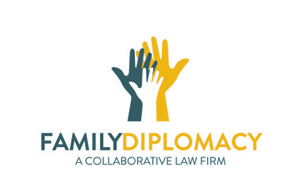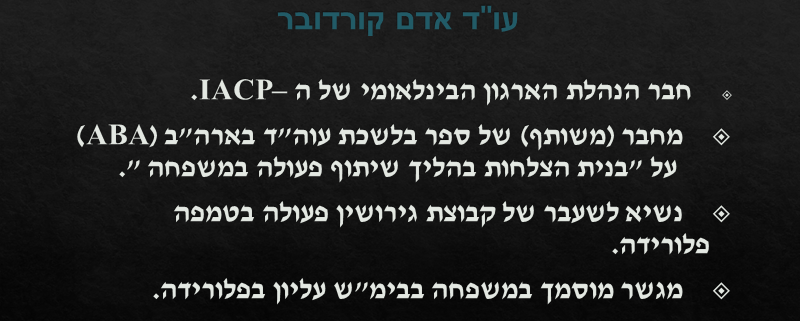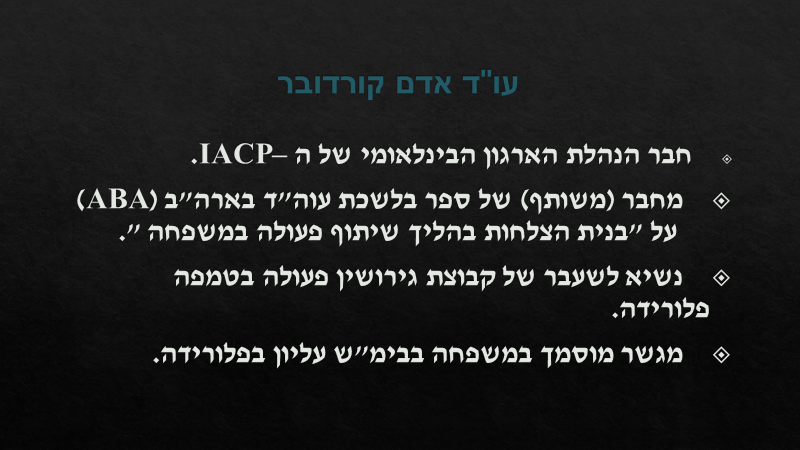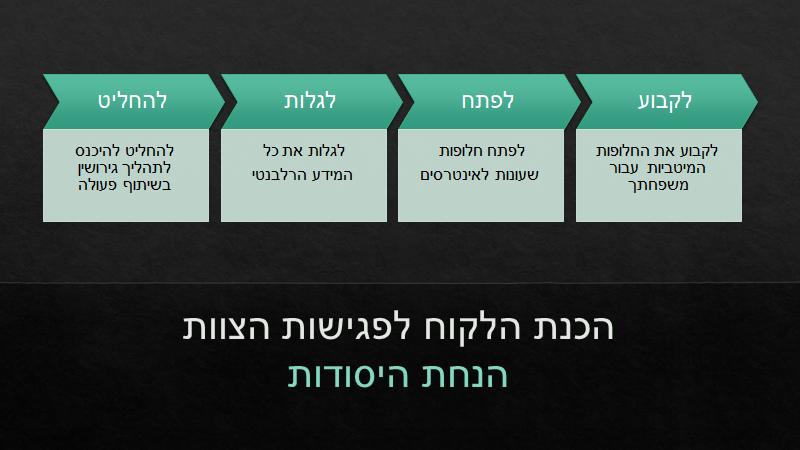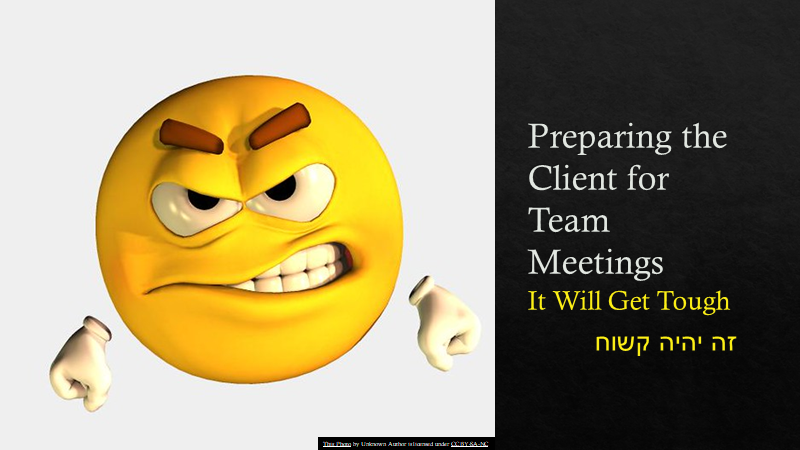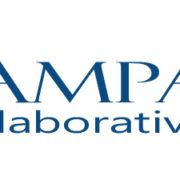Cordover Presents at Israeli Collaborative Divorce Training
Last week, I had the opportunity to present at an Israeli Introductory Interdisciplinary Collaborative Divorce Training. I was invited by Idith Schaham, a friend and trainer who taught at the first Hebrew-language Introductory Collaborative Divorce Training and a co-founder of many Collaborative Law Community Centers in Israel.
I presented alongside my Tampa Bay Collaborative Trainer colleague, Jeremy Gaies, Psy.D., with whom I traveled to Israel in December 2018 to discuss Collaborative Practice with fellow professionals.
My presentation focused on “Preparing the Client for Team Meetings.” Below you will find slides from the presentation, along with some explanation.
Introduction
The presentation started with my introduction.
This slide translates as follows:
Attorney Adam Cordover
- Board Member of the International Academy of Collaborative Professionals (IACP).
- Co-author of an American Bar Association (ABA) book on “Building A Successful Collaborative Family Law Practice.”
- Former President of Next Generation Divorce.
- Florida Supreme Court Certified Family Law Mediator.
Preparing the Client for Collaborative Law Team Meetings
My presentation focused on preparing clients for Collaborative Divorce Full Team Meetings (where both clients and all professionals gather around a table or in a zoom meeting).
The first step in preparing clients is to explain that Collaborative Divorce is a structured process. As laid out in the above slide, below are the steps of laying the foundation of the process:
- Decide to Enter the Collaborative Process
- Disclose All Relevant Information
- Develop Options that Meet Client Interests
- Determine the Best Options for Your Family
(Credit to J. David Harper, CPA/ABV for setting up this framework for explaining the Collaborative Process).
Interests versus Positions
The next step is to explain to clients that in Collaborative Practice, we focus on interests, rather than positions.
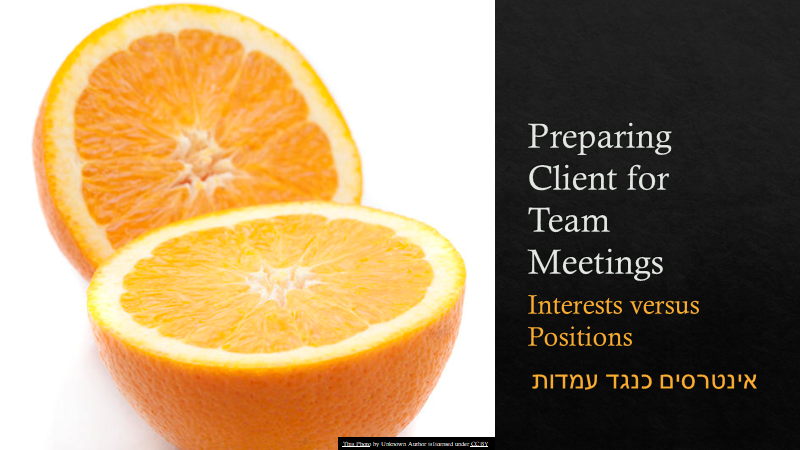 In other words, we try to stay away from a particular outcome, but ask what is important to the clients so we can build options that meet those needs.
In other words, we try to stay away from a particular outcome, but ask what is important to the clients so we can build options that meet those needs.
This is oftentimes addressed by telling the Story of the Orange. Henry and Wilma both want an orange. If they were engaging in position-based negotiations (where each simply argues that they should have the orange), they might go to a third-party, Judy, to ask her to resolve the dispute. Judy would then say there is a simple solution, cut the orange in half, so that each gets half of what they want.
In interest-based negotiations, Judy would ask why each wants the orange. Henry might say that he wants fresh-squeezed orange juice, while Wilma might say that she wants the zest of the orange to make a flavorful pie. Now, Judy can explain that Henry should get 100% of the juice of the orange, while Wilma should get 100% of the skin of the orange. Now, by focusing on interests, each gets 100% of what they want.
Crosstalk
Third, professionals should prepare clients that there will be crosstalk.
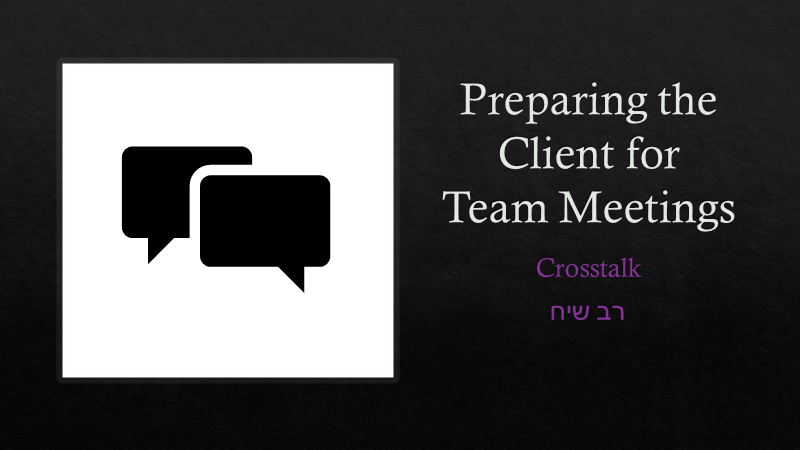 Crosstalk refers to the fact that, in the Collaborative Process, each lawyer will likely speak to his or her client’s spouse. Many clients may be surprised that I am friendly to their spouse during meetings, and that I may even bring up points that would seem to benefit their spouse. However, my goal is to help meet the spouse’s interests so I can ensure that my client’s interests are met; that is the only way to reach an agreement. Accordingly, I let clients know ahead of time that this will happen, so that they will not be surprised.
Crosstalk refers to the fact that, in the Collaborative Process, each lawyer will likely speak to his or her client’s spouse. Many clients may be surprised that I am friendly to their spouse during meetings, and that I may even bring up points that would seem to benefit their spouse. However, my goal is to help meet the spouse’s interests so I can ensure that my client’s interests are met; that is the only way to reach an agreement. Accordingly, I let clients know ahead of time that this will happen, so that they will not be surprised.
Keeping Your Eyes on the Prize
One question that I ask clients: How much will it cost to fight for a $100 lamp?
 Many clients are concerned about the costs of a Collaborative Divorce. I acknowledge that it is not cheap; divorce is not cheap. But there are things that they can do to make it less expensive. For example, if clients focus on big picture items rather than smaller items, it will cost less. For example, I advise clients not to spend thousands of dollars to fight over a $100 lamp.
Many clients are concerned about the costs of a Collaborative Divorce. I acknowledge that it is not cheap; divorce is not cheap. But there are things that they can do to make it less expensive. For example, if clients focus on big picture items rather than smaller items, it will cost less. For example, I advise clients not to spend thousands of dollars to fight over a $100 lamp.
It Will Get Tough
The final thing that I do to prepare clients is let them know that things will get tough.
I strongly believe that Collaborative Divorce is the best option for most families. And yet, it is still divorce, and divorce is tough. There will be times where my client will get angry during the negotiations, or sad, or hopeless. They will consider terminating the Collaborative Divorce and moving to a courthouse battle. And yet, the vast majority of Collaborative Divorces result in a full resolution, and most clients are content at the end of the day that they were able to divorce in a dignified manner. So, while things will get tough, understand that you will get through the tough times.
Conclusion
I ended my presentation by engaging in a question and answer session with the Israeli lawyers, mental health professionals, and financial professionals in attendance.
By the way, if you are a professional seeking to take a Collaborative Divorce training that meets the standards of the International Academy of Collaborative Professionals, my training team, the Tampa Bay Collaborative Trainers, is conducting a virtual training beginning next month. We are teaming up with My Collaborative Team, and the training will take place over five sessions, 3 hours per week on Wednesdays, from August 19 to September 16. The sessions will be from 3pm to 6:15pm Eastern Time. There are only a few spots left, and you can learn more and register at https://www.mycollaborativeteam.com/webinars/.
